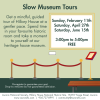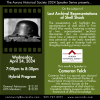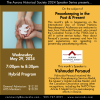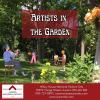Black, Annabelle (2014) Transcript
Transcription
Annabelle Black Interviewed by Seline
October 19, 2014
Seline: Ok, it’s October 19th, and I’m Seline, and I’m going to be interviewing Annabelle Black for the ‘Let’s Talk’ Aurora Project.
Annabelle: Good Afternoon Seline!
Seline: Good Afternoon Annabelle! So when did you come to live in Aurora?
Annabelle: Well we came in 1961, and we rented a house on Huron Court, that’s a street in the Aurora Heights subdivision, and I went over there this morning just because I was curious about what number of houses there were. And I counted 19 houses. But when we moved there, there were 60 children on that street!
Seline: Oh!
Annabelle: So there were a whole lot of – you know, people had a lot of children in those days, and uh just in 1959, the population of Aurora was 3000, and it had been 3000 forever. And in around 1959, a big plant called Sterling Drug, anyway I don’t know exactly what they made at Sterling Drug, but I think they made Lysol and Asprin’s and that kind of thing, and they moved here from Windsor, and two sub-divisions went into Aurora. Aurora Heights, and Regency Acres. And that was because the population had doubled in a period of two years. And uh my husband Wilf Black was a dentist, and it was a very dentist-friendly community. We had – the dentist population had gone up by zero, whereas the people needing care for their teeth had gone – had doubled. So, the three dentists were Dr. Henderson, and uh Dr. Sedore, and Dr. Bolen. And they were all so eager to have Dr. Black and me as help because the poor dentists were – there was a lot of tooth decay in those days, and they were just only being able to look after the people who were in pain. They couldn’t take any new patients. So they were very eager to have another dentist. And the Bolen’s were so good to us. Dr. Bolen had a little building at the corner of Mosley and Younge Street, and there was a little back room in it, it wasn’t very big, but it was big enough for one operating room, and a little waiting room, and they rented space for our office, and we got that set up, and then a couple of weeks, or maybe three weeks before we came, uh Dr. Black put a little wee ad in the paper, and there were very strict rules in those days. Uh – you couldn’t have printing more high then this, and uh it was you know very conservative. You couldn’t advertise in other words. You couldn’t announce that you were going to open an office. And Dr. Bolen, bless his heart, put a telephone extension in his office, and so his receptionist booked 90 patients for us by the time we opened the door.
Seline: Oh that’s amazing!
Annabelle: Well it was because most of the – our friends who had opened practices sat around wondering what to do for several weeks! You know, but we were busy from day one. And the Bolen family were really good to us. They’re maybe half a generation older than we were, but – Cuz’ I remember they had Larry and Lynda, their children were teenagers when we came, and we only had little Heather, who was a year and a half. And uh – but the Bolens you know took us to the Lions ladies night, and that kinda thing, and tried to introduce us to the people of Aurora.
Seline: Oh that’s good.
Annabelle: And we were really grateful to them for that. And just uh not this past summer, but the year before, Ms. Bolen died. She was in her ninety’s, and I was privileged to go to her memorial service, because I was very, very fond of her. So that’s a lot about uh – the dentist. Oh the other thing the dentist had that was great was the bad list! If you were one of those guys that went to the dentist all the time and never paid your bill, you know, and went from one dentist to another, they had a bad list and they gave that to Wilf so, if those people gave in, you got cash on the line from them because you knew they’d never pay you, so that was a good thing too that they did for us.
Seline: So, uh, when you moved here, I heard that you wanted to get involved in the community?
Annabelle: Well, yes I did, but to begin with, I really couldn’t get very involved because I had to go to work everyday. And I lived in the sub-division where there were 60 children on the street, but I wasn’t very acceptable because I had a nanny. I didn’t stay home with all these children like everybody else did. So I was frowned upon there because I was going to work everyday. But as soon as Wilf got more established, and could afford to hire somebody to work for him, then I could – started to stay home, and of course I was also unacceptable in Old Aurora, cuz’ you know I lived out there. So uh, then after I stopped working, I began to become more involved in the community, and I did lot’s of volunteer work. But I was going to tell you what Aurora looked like when I came here.
Seline: Oh what does it look like?
Annabelle: Well, uh down at the corner of Younge and Wellington, at uh where the Town of Dominion Bank is now, was a Queens Hotel. And that was owned by Mr. Jimmy Murray. Who was the Mayor of Aurora. I’m pretty sure he was the Mayor of Aurora when we came. Because that big street out by NoFrills is called Murray Drive, and that’s not an accident. That was after the Mayor. And the other people I can think of on council at the time were Dawn Glass, and we have a Glass Drive out there, and Davis Drive, that was Clarance Davis, and Stute Patrick was on the council, so there’s a street named for him as well, and uh, then uh, I think I can’t remember what year the Queen’s Hotel was knocked down, and uh, the bank was built. And then next door on the other side of the parking lot was where Macs Milk just closed, I don’t know, last year –
Seline: Really? It just closed?
Annabelle: Ya, it’s closed. And that store was – had been converted from the movie theatre and that was the IGA grocery, so we all went there to get our groceries. And down on the main street of, uh – on Younge Street, between Mosely and um, Wellington, there were three drug stores. I’m pretty sure there were three drug stores. Certainly there were two little pharmacy’s there. And then there was, uh, a wonderful bakery, and all the people from Toronto used to drive up Younge Street to get to their cottage in the summertime, and just South of Mosely Street, was Cousins Dairy, and all the people used to come up, and stop and get their kids an ice cream cone, at Cousins Dairy, and then they’d stop at the Bakery, and uh, and get a – I think it was Petersons Bakery – and they’d get bread to take to the cottage because they made really, really good bread. And then up at the uh, opposite corner from the where the TD bank is now, uh, on the South side of Wellington, was our Dills Department Store, and uh, then across the street where the Montreal Bank is, was a wonderful Bank. It was shaped like an octagon. Such an interesting building – and the manager of the Montreal Bank always lived on the second floor. And I was in their house once, and it was very interesting because of course it was shaped like an octagon. And I hadn’t been in a house like that before, and uh, I can’t remember what was on the other corner, on the South side of Wellington, and the West Side of Younge. I can’t remember what was there. Then, uh, across the, uh, on the East side of Younge Street, was Wilsons Hardware, and they eventually moved across the street to where the Hardware that just recently closed beside Aw Shucks is uh, was Wilson’s Hardware. And uh, we had one high-school, which was Dr. GW Williams, and then, we had Wells Street School. And the first year that we lived on Huron Court, in Aurora Heights, they built Aurora Heights School. So it was built in 1961 or two, I know – oh I think probably 61, and uh, Regency Acres School was probably built about that same time.
Seline: So around the time you moved to Aurora?
Annabelle: Ya. Well they had to because you know – when you build a populations has a kinda big impact and uh, anyway we lived only there on Huron Court for one year and one of our patients came in and her husband had been – they were living in a house at the corner of Spruce Street and Catherine Avenue, and that house belonged to the Model’s. And Roley Model was a teacher here. And he had gone, I think it was Togana on a sort of foreign exchange program of some kind, and he was teaching there. And this family lived in – had rented their house when they went away, and uh, her husband was transferred to Whitby! I mean today, you just get in your car and shoot over to Whitby, for work! You know, but in 1961, you moved to Whitby! So – or rather ’62 by then – so, we said “Oh! We’d like to live downtown, we’ll come rent it!”. So we did! We moved there, and we lived there, uh, in that big house in the corner of Spruce and Catherine, where the Crealmins live now, and we really liked living in the old part of Aurora, and then in 1963, uh, Wilf was walking home from work, and uh, a house had come for sale on Victoria Street. Just uh, between – well it wasn’t a parking lot then – but it is now. The parking lot and the Baptist church, so it was close to Wellington, and so we went down and had a look at that, and that’s the house we finally bought, and moved there in 1963, and uh, lived there for 40 years.
Seline: Wow!
Annabelle: And I used to uh – it was close to the town park, and uh, so , my children would go to the town park to play, and I’d say “Well, come home when the clock rings!” and that was the town clock, over at – it was in the post office, and so, they’d come running back when the clock rang, and then I’d say, uh “No, I didn’t get the dinner ready yet, go ahead back to the park.” The kids all just kinda ran wild, in Aurora in those days, and they had a good time, and uh, I don’t know. Then I started to do a lot of volunteer work. And one of the chief things I did was work for – it was called the association for mentally retarded children at the time. It’s called the association for community living now. But I did a lot of volunteer work with them, and raised a lot of money, I was uh – the first job I had was in was public relations. That was in the mid 60’s I guess, and so much of the society just wanted to hide the mentally challenged people at that time, and put them in institutions, and so on. And people didn’t realize how many mentally challenged people were living right in the community. And so my job, I loved it. It was – well you can tell because I like to talk – they wanted me to – they made a presentation of slides, and then I’d go to every presentation that wanted a speaker, and tell the programs that we were developing for the mentally challenged people. And we had a little school up in Newmarket, and um, people went there until they were 18 or so, and then they went to – we had a sheltered workshop where we got contracts from local businesses that needed, you know, kind of like chores done like putting together a newsletter for example, and the people would do that, with supervision, and it gave them a more normal feeling because they were going to work just like everybody else in the community is going to work, so um, I did that, and I did a lot of other volunteer jobs. I’m an old worn out door to door canvasser. I canvased for every outfit that needed a dollar, but then you see I could get all those people to canvas for me when I needed to raise money.
Seline: Ya.
Annabelle: So, um, and uh then in 1971 Mearial Lanaway who many people would know from Aurora, she’s uh, no longer living, but she nominated me to be the Citizen of the Year. And I won that honour which was really a big deal, because uh, I’d only been in the town for ten years, you know, it takes a long time. As a matter of fact, when I came here to the orientation meeting that night, some lady – I don’t know who it was because you see I can’t see anymore but, some lady said to me “when did you move to Aurora?” and I said “Well, 1961,” “Oh!” She said, “You’re a newcomer.” You know? And that was the way it was. It was uh, quite a surprise to me. I was the second Citizen of the Year in Aurora, when uh, I can’t remember I think it – Dick Illingworth was the Mayor. And they had students from the high-school come to the council meeting, and Steven Ostick – many people will remember the Ostick family, and uh, Steven was at high-school, and he suggested to the Town Council, you know in 1969, or ’70 or something, that he thought they should choose a Citizen of the Year. Each Year, uh, who was making a contribution to the community, and the council picked that up, and decided to do that. And uh, so, Bob Lick was the first person that was named, and then I was the second one. But it was terrible because Dick Illingworth phoned me up, a couple weeks before the July celebration, and said uh, you’re going to be named the Citizen of the Year, and you can’t tell anybody.
Seline: Oh.
Annabelle: And uh, well I told my husband, but it was really hard for me because I’m not a good liar. And I had to keep that quiet, but I wanted to have a party so, uh, we had the party anyway. But I managed not to tell anybody that I was the Citizen of the Year. And we used to have such a good time at the First of July celebration because on uh, the night before, on the 30th of June, they have a dance at the community centre over on Aurora Heights Drive, and all the kids would go dance, it was like going to a wedding dance, you know ‘cuz little kids would go to that dance and then the next day they’d have the parade in the morning, and the beer garden in the afternoon, and a little dance at night, it was really uh- a fun celebration, and uh, I think it started in I- I don’t remember. We celebrated Canada’s centennial in 1967 which was a big celebration, and I think that the council and the committee decided: let’s call Aurora ‘Canada’s Birthday Town’, and we’ll have this celebration every 1st of July, and well, we’re still having it, but that was when I remember when it got started. I made a few notes, but I don’t know.
Seline: That’s alright.
Annabelle: I think I told you everything. I have to write big because I can’t see.
Seline: Ya, that’s alright.
Annabelle: Oh ya! We didn’t have a liquor store! If you wanted to do something really simple like have a bottle of wine, you had to drive up to Newmarket to get one. And I remember we had a referendum, and Aurora went ‘wet’. You know, you could order a glass of wine with your dinner, and before that, you couldn’t do that! And the skating rink – I should have talked about this when I was talking about beautiful downtown Aurora earlier – but the skating rink was down on the east side of Young Street; just North of where the Park Place Manor retirement home is now. And I think the lot is still vacant! And they talked, and talked and talked about what was going to go in where the old arena was but it burned down. I can’t even remember when it was, it was the early 60’s I think. So we didn’t have a skating rink at all, until we were able to build the community centre up on Aurora Heights Drive. So, oh everybody walked everywhere and, oh I mentioned earlier how many families came to live in Aurora Heights and Regency Acres. And in fact, people used to call it ‘Pregnancy Acres’ instead of Regency Acres because everybody was raising a young family, and you know the mothers were at home, and the fathers got in their car in the morning and went to work and uh – well other than the people who worked in town, or worked at sterling drugs, who would walk to work. But most mothers were at home, and the fathers took the car and went to work! So the mom would send a little note to the teacher, that Darren has an appointment with the Dentist at two O’clock, and the teacher would send him off, and then Darren would jump on his bike and ride downtown, and go to the dentist then get on his bike and ride back to school! It was really easy to live here in those days.
Seline: Oh that’s amazing.
Annabelle: And 1967 was a great-fun year when we had Centennial, and we all got costumes, and there were lots of activities and we had a good time. And uh – are – well we went to Trinity Anglican church and the priest at the time was John Turns and he was a very popular churchman and he was the clergyman for the town, and he and his wife and children went to everything that went on in town, and so on. And he died just 2 years ago in Barrie. He was 95. He was a very interesting man, and a nice, nice family, and he became friends with – I told you I wanted to talk about the Caruso Family. And of course they were – their fruit and vegetable market and flower shop was on the main section of Younge Street also, and still is. I think the sign on that mural says “Since 1914”. There were many families who had been there. And when I used to shop there, the ladies that waited on me were Ms. Rose Caruso, and Ms. Mary Caruso. And as old as they became, there were referred to as ‘never having married yet’. And I don’t really know – I was thinking about that well, there was a whole generation of Canadian women who remained single because all the lads had been killed in WW1, you know. Anyway, the Caruso family became friends with the Spears, and we were there at the same time at their house. And uh – of course the Caruso family, who were Italian descent were Roman-Catholics. And I remember see – Mary and Rose saying one night while we were there “well” – well I was just really thinking about this because they’re in the Vatican in the next step of the beatification. Um, John the 6th I believe his name was, was a very progressive pope, just like the one we have now, and he was trying new things just like the cardinals of Buckingham. Anyway, he had something in the 60’s called Vatican two, and there were a lot of changes in that church and that was a result of Vatican two. And I remember Rose and Mary Caruso describing that – that um when we were young, we didn’t have a church here in Aurora, we had to go to a church in Richmond Hill and our friends all went here in Aurora, but that was ok. Because we were right, and we heard our mass in Latin, our friends heard theirs in English, but that was ok because we were right. And all our friends went to church on Sunday and they sang Hymns and we didn’t sing the Hymns, the choir sang the Hymns, but that was ok, because we were right. Well then, Vatican two happened, and they said to Mr. Spears “You know, we were at church the other day, and we heard our mass in English, and we were singing Hymns, and uh we were making them up. We weren’t even right! You know. ” and I just thought that that was such a great conversation to hear, and I liked those two women so much, and they worked so hard in that store, and uh – so that was just why I liked to talk about the Caruso family, and the Spears family.
And then, when our Priest, when John Spears was transferred to Toronto, there was this lovely clergyman at the Presbyterian Church. And he kind of became the town clergyman at that time and it was a very tragic thing because um I can’t remember the year, but he died very suddenly. He – I think he got meningitis, and he died on a Saturday night, and all the Presbyterians went to church on a Sunday and they didn’t have a clergyman. And that was a big tragedy in Aurora and um, by that time, we had an IGA Grocery Store over – well over by where Dollarama is and now there’s all of, whatever that store’s called – that they’re rebuilding right now, and uh, there’s a coffee shop in that IGA, and all the old guys used to congregate there, and drink coffee and smoke, and I heard one old guy say “well I can’t die now for sure” he said, “I thought John Spears would bury me, and he moved away, now Homer Mackevoy died, so there’s nobody to bury me.” That’s what I mean when I say they were kind of the town clergymen, but not so much the congregation. But everybody had some kind of ownership there, so, I don’t know.
Oh! I know another tragedy that happened in 1972, our dental office burnt down! We had moved from Dr. Bolen’s office at Mosely and Younge, because we needed a bigger office. So we were getting a middle of the block on the West side of Younge Street, uh, between Mosely and Wellington, and uh, there was a – at this point, there was a passageway, if you park down by the West side of those stores there like Aw Shucks, those stores, there’s a passageway to walk up to the sidewalk on Younge Street if you park down there. And many years ago, apparently, that was, I’m thinking about something else here. I forget the name of the street. Anyway, there was a passageway that came up between two buildings, and sometime in the past, I don’t know when, we didn’t even know this at the time, when we moved here, we were on the second floor of one of the buildings. Anyway, somebody came along, and didn’t think they needed that passageway anymore, so they bricked up the front and the back, and put a floor in, and made another store. And there were windows leading into each building, either side of where they built this new store. But because of not having building codes that were strict at that time, they just boarded up the windows, you see, and covered them up, and so on. But at the time, our office was upstairs way back in 1972 – I think we moved there – we moved to that office in 1967. On Younge Street upstairs, and um, a little fabric shop was in that store, it used to be a passageway, but we didn’t know that. And then the fire broke out, it was nine o’clock at night, and the fire broke out in that fabric shop, and it was full of lots of uh, synthetic fabrics, so you could image, it was just a real configuration in no time. And of course, because of these windows, that were boarded up, the fire got through the windows, and got in on either side, and Tommy Bursans’ Law office was downstairs from our office, so he got burned out, and we did, and I think on the other side, there was a shoe store, and I can’t remember what was upstairs from that, and that was a real terrible event in our lives. Because Wilf was out of work for six months, before we could get ourselves another office, and I don’t think they start to manufacture dental equipment until they get an order for it, you know? So it was forever before he got back to work, so that was and we had a volunteer fire brigade, of course, and a lot of the firemen were our patients, we were at a meeting over at our church, and Doris Doncox who lived over by the funeral home over on George Street, and she came running over to our house, and the babysitter said, well, they’re over by the church, so she came and got Wilf, and he ran downtown, and one of the firemen was Wilf’s patients, and he tried to take Wilf in, but he got – he just couldn’t handle the smoke, so it was Jody Gear. And he put on some kind of mask, and went up to the office, and he knew the office, because he was our patient, and he brought down this little file, which was our accounts receivable. And that’s the – that’s the record of everybody that owed us money, and, so I think we finally got the appointment book out, because it was all wet, I remember taking it home, and putting a paper towel between each page, but because people cancelled their appointment, or phoned up and needed to change it, that was all written in pencil, that was all – the water damage – we could still read it. And then when we finally did get back to work, it was quite funny because everything was new, shiny new equipment, it was built, uh, oh I guess we moved across the street, because then we had our office, where the clock tower is. But it was, shiny new equipment, and the whole new, we built this new office, and then we walked in with the treatment chart. And it would be black with smoke, and our treatment charts didn’t burn. They had a lot of smoke damage, but they were in files, and they got wet, and so we were lucky because we had all our records saved from the fire, but that was a pretty traumatic time for us because we uh, well Wilf was out of work for one thing, but you know, you want to keep looking after your patients, and one of the other dentist, Dr.Blathe asked Wilf to come. He would loan us his operating room, half a day, and uh, so we were able to keep up to some extent with our patients, but people back in the, that time had a lot of tooth decay, so you really had to try to keep on top of it. I don’t know, what else do you want to know?
Seline: Um, so were you a part of the Trinity Church?
Annabelle: Oh yes! And I still am. And I did lots of volunteer work over there, I did lots of community work, anyway, that’s all in the ancient history of how I got to be the citizen of the year, but I’m very proud of being able to do that in Aurora, and Aurora’s been very good to us, I’ve had a good life here. Dr. Black died in 2002, and we had retired, and sold our practice in the 1990’s, we had a few years of having leisure, which was good, and uh, Heather and Bruce went to school here in Aurora, and it’s been good for us. I’m trying to think of the name of the, oh, we drive down that street all the time. Um, hmm, isn’t coming to me. But it’s a great street; it’s the street that runs, uh, it runs North and South, just at the east edge of the Town Park? Macheal Street! Oh no, Macheal Street is in the South end, I don’t know why I can’t think of it, uh, when we drive, I live over on Centre Street now, and when we drive to church, we drive down that street, and it’s on the edge of the park, and um, at the end of the street, on Metcalf Street, I just love driving down the street that I can’t think of the name of, because at the end of that street, you look, and there are about 6 or 7 houses, they’re two story houses, but they’re all the same, and some of them have had a porch put on the front, or something, but those houses are the same, uh – oh it’s Larmont Street! That’s the name of the street, and if you drive South on Larmont, you can see all these houses, and that was, those houses, were built by the Sisman Shoe Company. Which was a big employer here in Aurora, for many, many years, and it was still in operation when we moved here. But those houses were built by the people who worked for Sisman Shoes, to live in. They are all the same, and they’re still, just really nice looking little houses. And uh, I think you had to go to the end of Metcalf Street. I’m not sure where the Sisman Shoe Company was – I think it might have been on the other side of – on the East of the tracks, but I’m not sure. But anyway, the people lived there. And the street I live on now, Centre Street, just near the railroad tracks, on the uh North side, of Centre Street, there are about four houses that all look alike. And I don’t know if they were built by another company, or not but uh, kind of an – kind of interesting to see that architecture. It’s all the houses are the same. Another business that was big in Aurora was Collis Leather, and that was the tannery down on uh, Tyler Street, and it was still open. Our patients – many of our patients worked at Collis Leather, and that was a big industry in Aurora for many, many years. Anyway.
Seline: So what is your best memory of Aurora?
Annabelle: Well I think being named the citizen of the year is one of the best memories, that was pretty good, but I mean I have lots of good memories living here, but it was hard for me at the beginning because for the – for the first place, I was from Saskatchewan, and I was a poor relation of Ontario, you see, and here’s Aurora, full of F.O.O.F’s! Do you know what F.O.O.F’s are?
Seline: No…
Annabelle: You don’t?
Seline: I don’t, sorry.
Annabelle: Fine Old Ontario Families. I was not one of those. But anyway, ok, I think I’ve talked enough.
Seline: Well thank you so much.
Annabelle: My pleasure.
END of Seline’s Interview.

















